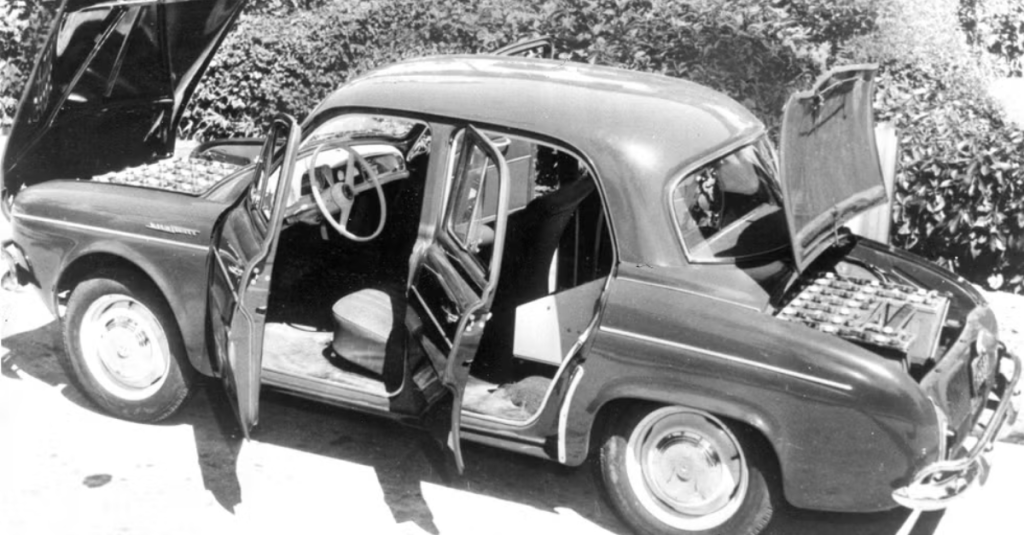What are alternative fuels?
Alternative fuels are fuels sourced from non-petroleum and often renewable resources. This includes but is not limited to fuels made from fossil fuels that burn cleaner and others from plant-based materials or organic waste. In a previous blog, we covered what alternative fuels are and why they’re important. Now, we’ll go over the history of these alternative fuels and how and why they have regained popularity.
When were alternative fuels first invented?
Alternative fuels have been around as long as petroleum-powered vehicles. While they initially had widespread popularity during the first development of vehicles, gasoline proved to be more popular and less expensive, and many alternative fuels’ production was greatly decreased. However, in more recent years, alternative fuels have become increasingly important to the environment, the health of the country, and in decreasing foreign fuel reliance.
Biodiesel and renewable diesel
Biodiesel and subsequently renewable diesel have a long history. Rudolf Diesel, a German mechanical engineer that invented the diesel engine, showcased vegetable oil fuel for his new invention, the diesel engine, at the World Exhibition in Paris, France, in 1900. At the exhibition, he ran his engine on peanut oil, as the first iteration of the diesel engine could run on a variety of fuels. However, shortly after this death, petroleum became more widespread and diesel engines were redesigned to accommodate only diesel fuel.
As early as the 1930s, there was interest in separating the fatty acids from the glycerin in vegetable oil to create a thinner product resembling petroleum diesel. In 1937, Georges Chavanne received a Belgian patent for an ethyl ester of palm oil. By 1938, a passenger bus powered by palm oil ethyl ester was operating between Brussels and Louvain. While petroleum still reigned supreme in the 1930s and 1940s, vegetable oils were periodically used as diesel fuel, especially with fuel shortages during World War II.
Biodiesel gained more popularity during the 1970s, when the petroleum oil embargo had many countries looking for alternatives. The viscosity of vegetable oil, however, was causing damage to modern diesel engines, and so scientists began looking more closely at how to convert vegetable oil and animal fat into something similar but thinner.
Studying this led to the modern creation of biodiesel and renewable diesel. While both are made from animal fats and vegetable oils, biodiesel is created by a process called transesterification and renewable diesel is made by hydrotreating, gasification, pyrolysis, and other biochemical and thermochemical technologies. These different processes produce two distinct fuels. Biodiesel is a mono-alkyl ester of long-chain fatty acids that meets ASTM D6751 and is commonly mixed with petroleum diesel or used in its pure form (B100) in engines designed or modified to operate on it. On the other hand, renewable diesel is a hydrocarbon that meets ASTM D975, the standard for petroleum diesel, and can be used as a standalone fuel in virtually all diesel engines without modifications. Additionally, biodiesel and renewable diesel have historical and geographical differences. The growth of biodiesel was heavily supported by soybean producers to grow the soybean oil market, with the Midwest containing 70% of U.S biodiesel capacity. Renewable diesel’s capacity is most heavily concentrated around the Gulf Coast states at 60% and began with animal fats.
Biodiesel gained more traction in the US when it first became commercially manufactured in Kansas City, Missouri, in 1991. A few years later, Yellowstone National Park began using biodiesel in its vehicles and upon its success, many other national parks adopted the fuel as well. Renewable diesel’s major growth came nearly 20 years later, when Tyson Foods helped develop the first large animal fat renewable diesel facility in the US in Louisiana.

In the early 2000s, there were 25 biodiesel plants in the US but by 2009, that number had grown to over 200 manufacturers, in part due to high oil prices after the 9/11 attacks. Additionally, energy policy acts and the recession at the end of the 2000s greatly expanded the biodiesel market. More recently, the National Renewable Fuel Standard mandates that petroleum companies purchase alternative fuels based on the volume of traditional petroleum fuels they sell, generating a greater biodiesel production. Much of the expansion in renewable diesel production has come from converted oil refineries, which already have the infrastructure for hydrogen treatment and the logistics to handle large shipments of raw materials.
One of the most significant differences between biodiesel and renewable diesel currently is their contrasting consumption trends. While biodiesel use in the US peaked in 2016 and declined by 24% by 2022, renewable diesel has surged, growing nearly fourfold over the same period. In 2022, renewable diesel consumption surpassed biodiesel for the first time.
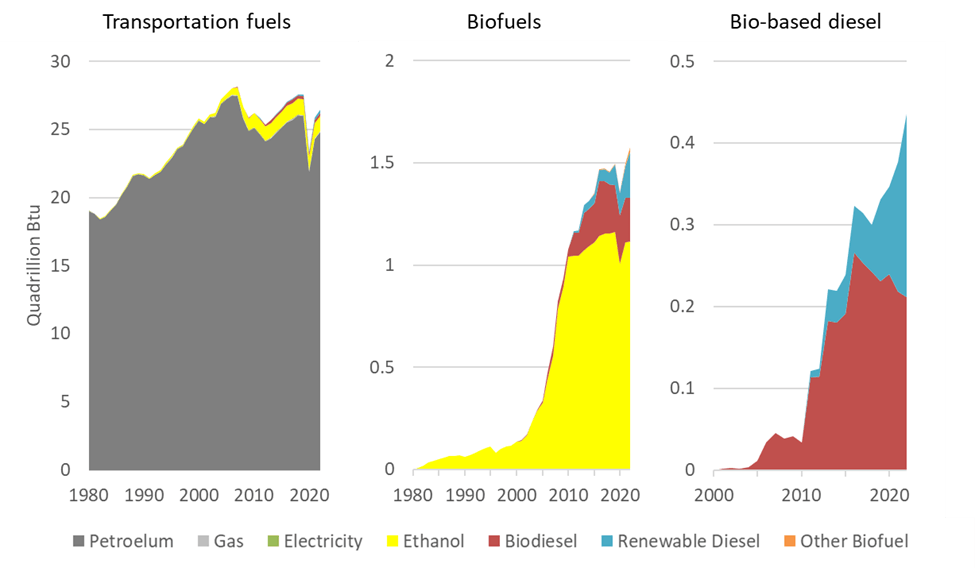
Ethanol
Ethanol was first used to power an engine in 1826 by Samuel Morey, an American inventor who developed an engine that operated on ethanol and turpentine. In 1876, Nicolaus Otto, the inventor of the modern four-cycle internal combustion engine, used ethanol to fuel an early engine. By the 1850s, ethanol also served as a lighting fuel, but its use declined when it was taxed as liquor to help fund the Civil War. After the tax was repealed, ethanol regained its popularity as a fuel source. Henry Ford’s quadricycle ran on pure ethanol in 1896 and in 1908, the Model T was created and could run on ethanol, gasoline, or a mix of the two.
During World War I, fuel demand surged, increasing ethanol consumption to 50–60 million gallons annually. In the 1920s and 1930s, ethanol gained popularity in the Midwest, with over 2,000 gas stations providing ‘gasohol’ (gasoline blended with 6-12% ethanol). Ethanol further gained significance during World War II due to fuel shortages, though afterwards, use was greatly reduced.
However, problems with foreign oil came to a head in the late 1970s, driving prices up and heightening interest in alternative fuels. To encourage less reliance on foreign oil, the Energy Security Act of 1980 was passed, which aimed to boost ethanol production and ethanol began gaining traction once more. The legislation provided insured loans for small ethanol plants and directed the Secretaries of Agriculture and Energy to devise a plan to raise ethanol production to at least 10% of the gasoline supply by 1990. Two years later, Fargo, North Dakota, hosted the first International Conference on Plant and Vegetable Oils, covering topics such as fuel costs, vegetable oil as fuel, additives, and extraction methods. Additionally, during this time, lead was no longer allowed to be in gasoline and ethanol could be used as an alternative octane booster.
Since then, ethanol has continued to increase in popularity. In 1988, the Alternative Motor Fuels Act was passed, which provides credits to automakers towards meeting their corporate average fuel efficiency (CAFE) standards for manufacturing alternative-fueled vehicles, including E85 blends of ethanol. With Clean Air Act amendments and the Energy Policy Act in the 1990s as well, ethanol became more widely used and vehicles made to run on E85 (85% ethanol) were adopted for specific car fleets.
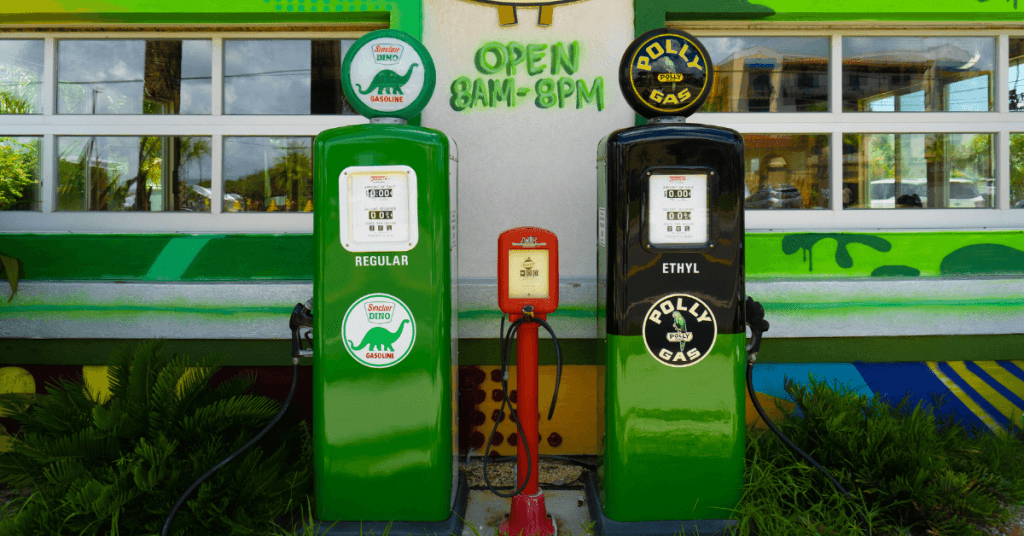
By the end of the 20th century, US ethanol production rose to more than one billion gallons. Further energy policy acts were passed in the early 2000s and ethanol production continued to increase to fulfill the new requirements and demand. By 2016, ethanol consumption made up more than 10% of the US’s fuel and two years later, ethanol production had increased to 16.1 billion gallons.
Ethanol has become even more popular in recent years, as the war between Russia and Ukraine has made domestic fuel supplies more necessary, and so certain barriers have been removed to allow for more ethanol production. Certain ethanol producers have committed to making ethanol a net-zero carbon fuel by 2050 or sooner. In 2024, the first commercial ethanol for jets Sustainable Aviation Fuel facility began operating in Georgia, making even air travel more eco-friendly.
Compressed natural gas (CNG)
Compressed natural gas (CNG) experiments began in 18th-century France, but the use of natural gas as a fuel began in the Po River Valley in Italy during the 1930s. The origins of CNG vehicles trace back to World War II military research, exploring its potential as a fuel for overland transports and heavy-duty vehicles in the wake of petroleum shortages.
By the mid-20th century, companies like General Motors began experimenting with natural gas for passenger and commercial vehicles. Advancements in technology, rising fuel costs, oil shortages in the 1970s, and growing environmental concerns led to collaborative research efforts by both industry and governments to develop CNG as a more popular alternative to conventional fuels. Since then, CNG has been used as a fuel, with Italy and New Zealand leading early adoption; North America’s interest grew in the late 1980s.
Since the 1990s, many countries have adopted CNG for vehicles, with Iran, Pakistan, Argentina, Brazil, and China leading in usage. Rising fuel prices and environmental concerns have driven demand, with nearly 14.8 million natural gas vehicles in use by 2011. As a cost-effective, cleaner alternative, CNG continues to gain popularity. The main driver behind the growing use of CNG as vehicle fuel is its cost-effectiveness, as the price of natural gas is lower than that of gasoline.
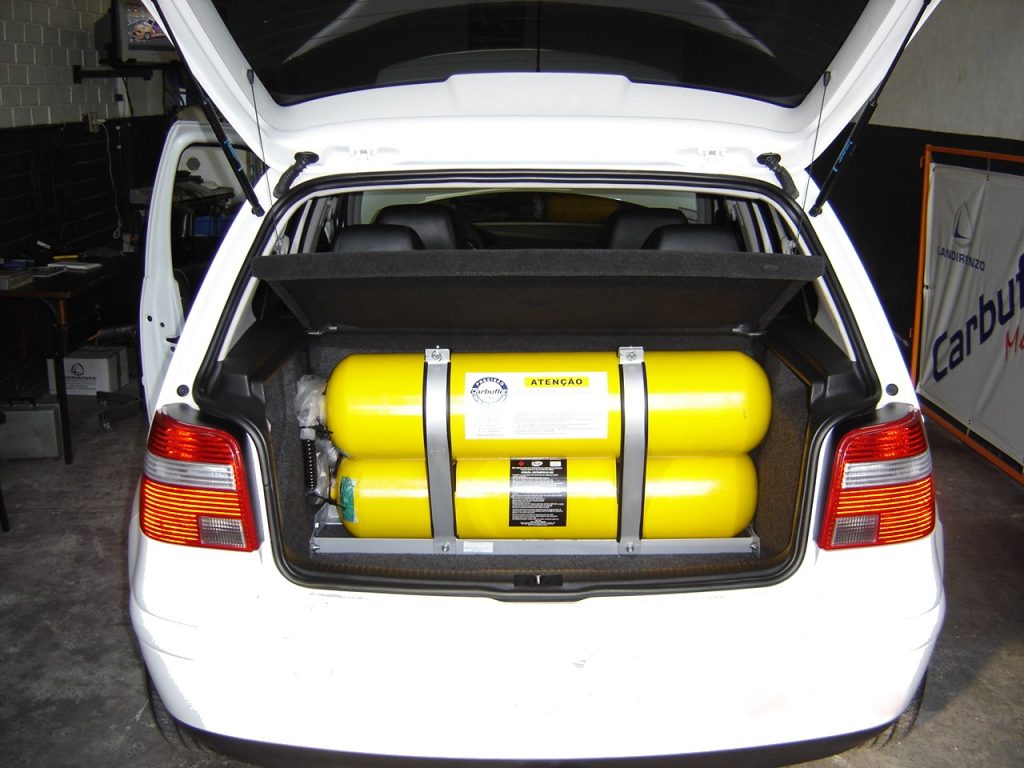
In recent years, CNG has been most adopted by the public transportation sector through CNG buses, offering the dual benefits of reduced emissions and lower operational costs. Organizations and municipalities across the US have integrated CNG vehicles into their fleets, demonstrating the practicality and advantages of this alternative fuel.
Propane (LPG)
Propane’s history dates back to the mid-19th century, when French chemist Pierre Eugene Marcellin Berthelot first synthesized it in the 1850s and 1860s while conducting experiments with organic compounds. In 1867, industrial chemist Dr. Edmund Ronalds discovered propane as a naturally occurring substance while dissolving Pennsylvania crude oil. However, it wasn’t until 1910 that explosives expert and chemist Walter Snelling confirmed propane as a volatile compound in crude oil. He made this discovery while investigating vapors leaking from a Ford Model T gasoline tank. After filling a glass container with gasoline, the cork popped out, revealing the presence of a volatile vapor.
Propane’s versatility extended to the automobile industry in 1913, when propane autogas was first used as engine fuel. That same year, Dr. Snelling was granted a patent for his method of producing liquid propane gas. A few years later, Snelling sold the patent, and others began developing new uses for the fuel.
Propane as vehicle fuel, or liquified petroleum gas, was first used in 1928 in a truck. By 1947, the first liquefied gas tanker was built and began service. In 1950, the Chicago Transit Authority ordered 1,000 LPG-powered buses, while 270 taxis in Milwaukee were converted to LPG in the same year. By 1958, LPG sales had reached 7 billion gallons, and in 1965, Chevrolet introduced four new LPG-powered engines for commercial vehicles. During the 1970s, Schwan’s, a frozen foods delivery service, became a propane autogas customer.
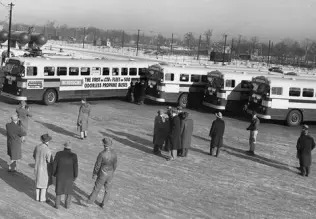
Propane’s status as a clean and efficient fuel was confirmed in the late 20th century. The 1990 Clean Air Act recognized propane as an alternative clean fuel, noting its lower emissions compared to other fossil fuels. This recognition was further reinforced by the 1992 Energy Policy Act. By 2004, propane had grown into a nearly $10 billion industry, with around 15 billion gallons used annually in the United States.
LPG is now the third most commonly used fuel in the United States, following gasoline and diesel. Over four million vehicles worldwide are powered by propane, spanning light-, medium-, and heavy-duty applications. While propane contains about 86% of the energy of gasoline, it requires more storage volume to match gasoline’s driving range. However, it remains price-competitive on a cents-per-mile basis.
Hydrogen
The first internal combustion engine, built in 1806, was powered not by gasoline but by a mix of hydrogen and oxygen. Swiss engineer François Isaac de Rivaz used a balloon to contain the hydrogen gas and an electrical Volta starter for ignition. However, the hydrogen-powered car he designed the following year was a failure. The first hydrogen fuel cell was developed in 1839 by Welsh inventor Sir William Robert Grove, known as the Grove Cell.
In 1860, Belgian inventor Etienne Lenoir developed the three-wheeled Hippomobile, the first functional hydrogen-powered car. Lenoir produced hydrogen by electrolyzing water, which fueled the one-cylinder, two-stroke engine. He eventually sold 350-400 Hippomobiles, paving the way for Karl Benz’s invention of the first patented gas-powered car in 1886. Although the first fuel cell was conceived in 1839, the term “fuel cell” was coined in 1889 by Ludwig Mond and Charles Langer, who created a prototype using industrial coal gas and air.
By the end of the 1930s, British engineer Francis T. Bacon created the first mainstream fuel cell, which was refined over the next 20 years to power a welding machine. In 1941, Russia converted 200 trucks to hydrogen due to WWII fuel shortages. Building on earlier work, Bacon further developed the hydrogen fuel cell, eventually perfecting the Bacon Cell in 1959. His design formed the foundation for the fuel cells used by NASA in its rockets. Upon the fuel cell’s invention, General Motors brought the Electrovan to market in 1966 as the first vehicle powered by a hydrogen fuel cell, which was capable of reaching 70 MPH and had a 150-mile range. The 1970s saw increased clean energy innovations, and by the 1980s, the U.S. Navy was exploring fuel cells for submarines.
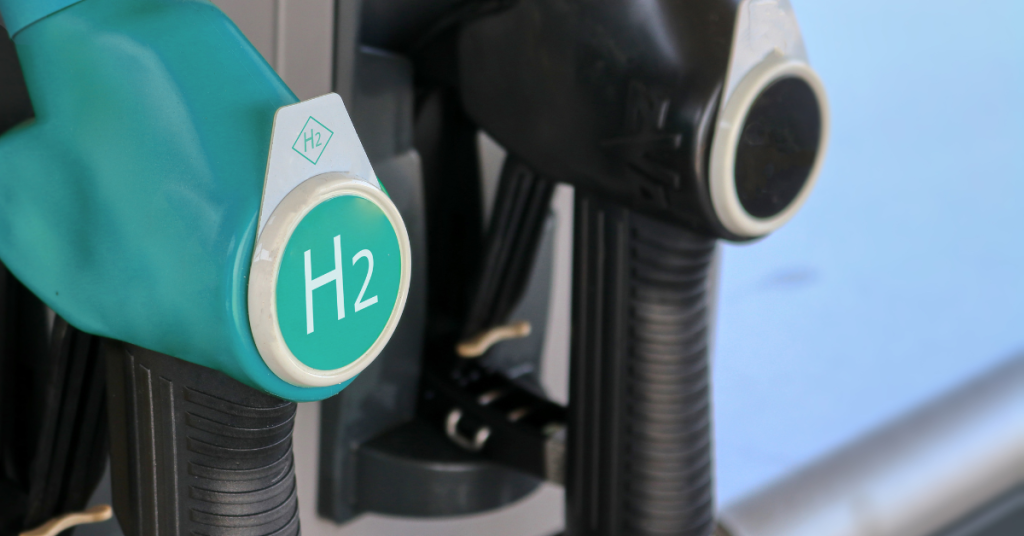
In 1998, Iceland planned to create a hydrogen economy and convert its public transport to fuel-cell vehicles. The next year, Germany opened the first commercial hydrogen station, and Daimler Chrysler introduced its liquid hydrogen vehicle, the NECAR 4.
The 21st century has seen a surge in hydrogen fuel cell research and development. In 2004, the German navy tested a hydrogen-powered submarine, and in 2015, China introduced the world’s first hydrogen-powered train. Countries like Norway, China, and parts of the UK began adopting hydrogen-powered vehicles, including fuel-cell buses, in 2018. This shift was complemented by the expansion of hydrogen plants, enabling nations such as Australia to produce and export hydrogen fuel.
The transition away from fossil fuels has renewed interest in hydrogen fuel cell technology, prompting major automakers like Toyota, Hyundai, and BMW to invest in its development. By February 2023, there were 56,000 passenger fuel cell electric vehicles (FCEVs) on the road. Currently, two hydrogen cars are in commercial production: the Toyota Mirai and the Hyundai Nexo.
Electricity
Electric car development emerged from breakthroughs in battery and motor technology in the 1800s. Early experiments came from inventors in Hungary, the Netherlands, and the U.S., including Vermont blacksmiths. In the 1830s in Scotland, Robert Anderson created a motorized carriage, but it lacked rechargeable batteries. Robert Davidson, another Scot, built an electric locomotive in the same period, but workers destroyed it due to its potential to replace steam engines. By the late 1800s, French and English inventors made more practical models.
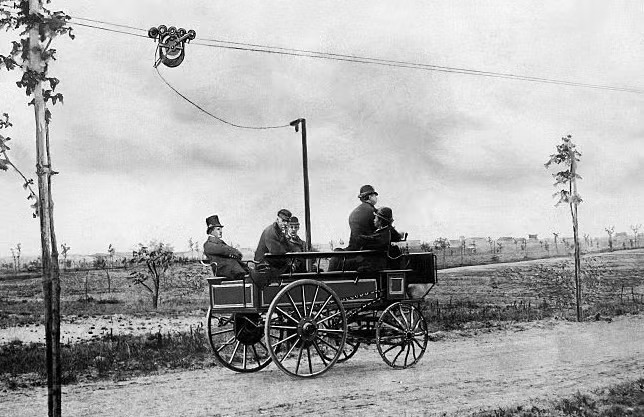
Rechargeable batteries arrived in 1859, making electric vehicles (EVs) more feasible. By 1884, Thomas Parker helped introduce electric trams and built prototype cars. Three years later, William Morrison of Des Moines, Iowa, created an electric carriage, which became a sensation at the 1893 Chicago World’s Fair. By 1900, electric vehicles made up a third of all cars, with New York City operating over 60 electric taxis.
The 1894 Electrobat, the first commercially viable EV, was developed by Pedro Salom and Henry G. Morris in Philadelphia. By 1896, the vehicle improved with lighter materials, pneumatic tires, and a 25-mile range. They went on to produce electric Hansom cabs for New York, and by the early 1900s, the Electric Vehicle Company (EVC) operated over 600 electric cabs. However, rapid expansion led to conflicts, and the taxi venture collapsed by 1907.
As gasoline vehicles gained traction, electric cars remained popular in cities for their quiet operation. However, with the introduction of Henry Ford’s Model T in 1908, gasoline cars became more affordable, and electric cars lost appeal due to their higher cost. By the 1920s, the electric car market had almost disappeared.
Electric vehicles stagnated for decades due to cheap gasoline. In the 1950s, a resurgence briefly appeared when Henney Kilowatt began producing electric cars, but with limited sales. The 1960s oil crises revived interest in EVs, with General Motors and Ford experimenting with electric prototypes. GM’s 1966 Electrovair II had a top speed of 80 mph and a range of 40-80 miles, but its expensive batteries limited its practicality.
By the 1970s and the continued oil criss, automakers were exploring electric cars more; in 1975, the postal service was provided electric delivery Jeeps by the American Motor Company to test run and a few years later, GM’s Chevrolet Chevette was converted into the Electrovette. However, low gas prices and limited demand caused the project to be shelved. As oil prices rose and gasoline shortages became more common, Congress passed the Electric and Hybrid Vehicle Research, Development, and Demonstration Act in 1976.
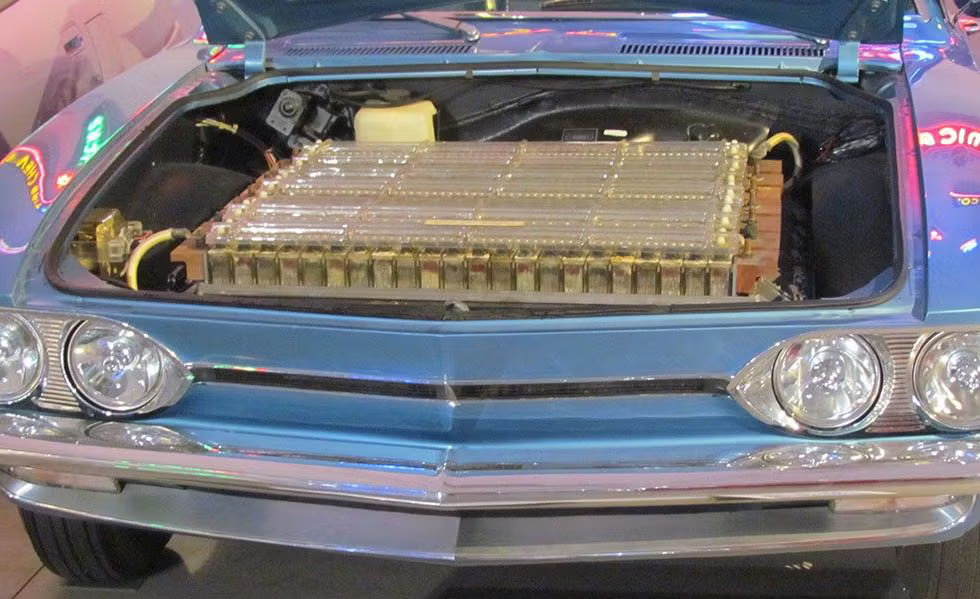
In the 1990s, new regulations sparked renewed interest in EVs. General Motors began selling the EV1 in 1996—the first modern era, fully-electric car. A year later, Toyota released the Prius in Japan, having spent $1 billion on development and becoming the first mass-produced hybrid electric vehicle. Just five years later, its sales would top 100,000, cementing its status as the leading hybrid. In 1999, Honda launched the Insight hybrid, sparking a wave of hybrid-electric vehicles in the U.S.
Tesla followed in 2006 with a luxury electric sports car. By 2010, Chevrolet launched the Volt, a plug-in hybrid using a gasoline-powered range extender and in 2015, the Nissan LEAF surpassed 200,000 sales, becoming the top-selling EV. Tesla unveiled the Model 3 in 2016 as an affordable $35,000 EV, drawing nearly 400,000 preorders in two weeks.
As battery technology has improved and infrastructure has expanded, EV adoption continues to grow, with over 234,000 plug-in electric vehicles and 3.3 million hybrids on U.S. roads today.
History of legislation for alternative fuels
Alternative fuel and fuel economy legislation began in California. After almost half a century of vehicles on the road, in the summer of 1943, the first smog episodes occurred in Los Angeles, prompting California to investigate what was producing the toxic pollution. Upon discovering that vehicle traffic was the culprit, air pollution control began in 1947 when California established the nation’s first air pollution control district.
Nationwide air pollution control began with the Clean Air Act of 1970, which aimed to reduce vehicle emissions everywhere in the US. The Energy Policy and Conservation Act of 1975 introduced Corporate Average Fuel Economy (CAFE) standards, while the Alternative Motor Fuels Act of 1988 incentivized alternative fuel vehicle (AFV) development with CAFE credits.
Key transportation laws include the Intermodal Surface Transportation Efficiency Act of 1991 and subsequent acts such as TEA-21 (1998), SAFETEA-LU (2005), MAP-21 (2012), the FAST Act (2015), and the Bipartisan Infrastructure Law (2021), all of which funded highways, safety programs, and AFV infrastructure.
The Energy Policy Act of 1992 mandated AFVs for certain fleets and was later amended to expand alternative fuel use. The Energy Independence and Security Act of 2007 raised CAFE standards and promoted renewable fuels. Other laws, including the Emergency Economic Stabilization Act (2008), the American Recovery and Reinvestment Act (2009), and various tax acts, extended incentives for alternative fuels and energy-efficient technologies.
Alternative fuels are vital to US success
Alternative fuels, vehicles, and infrastructure support the economy, environment, public health, and national security. Sourced from non-petroleum, often renewable resources, they promote domestic production and diversify transportation fuels. Additionally, compared to gasoline or diesel, alternative fuels generally produce fewer emissions, contributing to a cleaner future. Continued development and adoption of alternative fuels are necessary to the US and its constituents’ health and financial sustainability.
To see alternative fuel stations across the US and Canada, visit our station locator webpage, where we have embedded a resource from the Alternative Fuel Data Center.
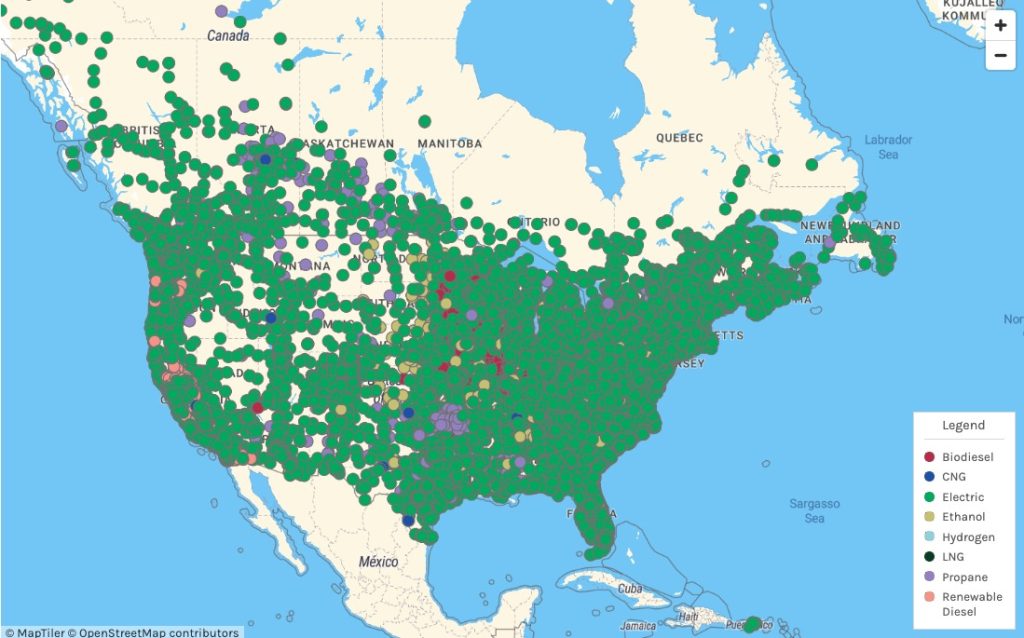

Whitney began working with IACT in 2023. With a degree in English and a minor in Art, Whitney has worked as both a newspaper reporter and a digital marketing and events manager, bringing 7 years of marketing and 8 years of content creation experience to IACT. Whitney is passionate about nature and preserving the environment, including solutions to cleaner air and greater sustainability, and is a former Chicago resident.



